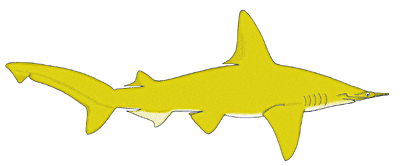
|
|
|
|
|
|
Shark Info (03-15-2001) |
Author |
|
Intro: |
Shark Info |
|
Main article: |
Dr. E. K. Ritter |
|
Article 1: |
John McKinney |
|
Article 2: |
Shark Info |
|
Article 3: |
Dr. E. K. Ritter |
|
Article 4: |
Shark Info |
|
Fact Sheet: |
Dr. E. K. Ritter |
|
Fact Sheet: Smalleye Hammerhead Shark
The smalleye hammerhead shark, or golden hammerhead as he is called in the only documentary film ever made of him, belongs to the rare species of hammerheads. The "film name" is attributed to its colorful appearance. Biology of smalleye hammerhead (Sphyrna tudes)Not much data is available on smalleye hammerheads because they have not yet been scientifically researched. As with all other hammerheads this species also has the prominently formed hammer-like head. DescriptionThe most important characteristic of this hammerhead species includes its striking head shape, golden coloration and - compared to its relatives - very small eyes which also account for its name. Compared with other hammerhead species, this shark has a prolonged second dorsal fin and anal fin. SizeThe maximum size of these animals is about 1.5 meters long, relatively small when compared to the largest representative of its family known as the great hammerhead (Sphyrma mokaran) which can reach lengths up to 6 meters. FeedingIt seems that smalleye hammerheads prefer to feed on small fish, however, a few stomach analyses have shown that they apparently also eat newborn scalloped hammerheads (Sphyrna lewini) in addition to softshelled animals. ReproductionAlthough its reproductory habits are relatively poorly researched, we do know that, as with other hammerheads, they are viviparous and have a yolksac placenta. Females reach sexual maturity after reaching a length of approx. 120 cm, males at 110 cm. The smallest pups seen to date were 30 cm long as they were captured, which presumably is their approximate size at birth. DistributionSmalleye hammerheads prefer the flatter regions (up to 12 m) of the Continental Shelf in tropical and subtropical regions. Their populations appear to be limited to the East coast of South America, from Venezuela to Uruguay. BehaviorOnce again we do not know enough about this species. Earlier research results turned out to be misleading because the initial description better matched the very similar species known as the whitefin hammerhead (Sphyrna couardi) rather than the smalleye hammerhead. Encounters with humansSmalleye hammerheads pose no threat to humans because of their size. May be published only by indicating the source: Shark Info / Dr. Erich K. Ritter |
|
|
|
|
|
|||||
